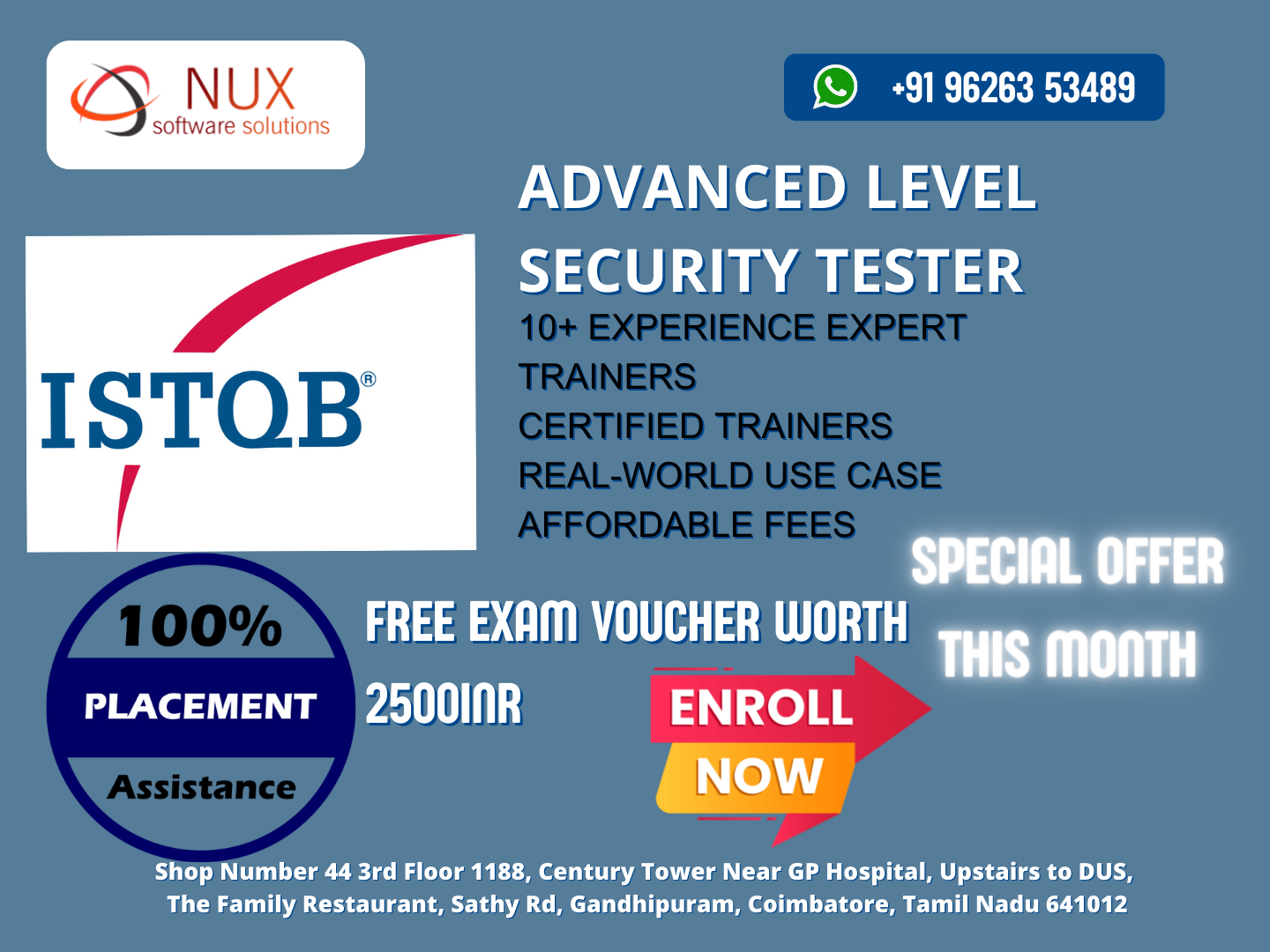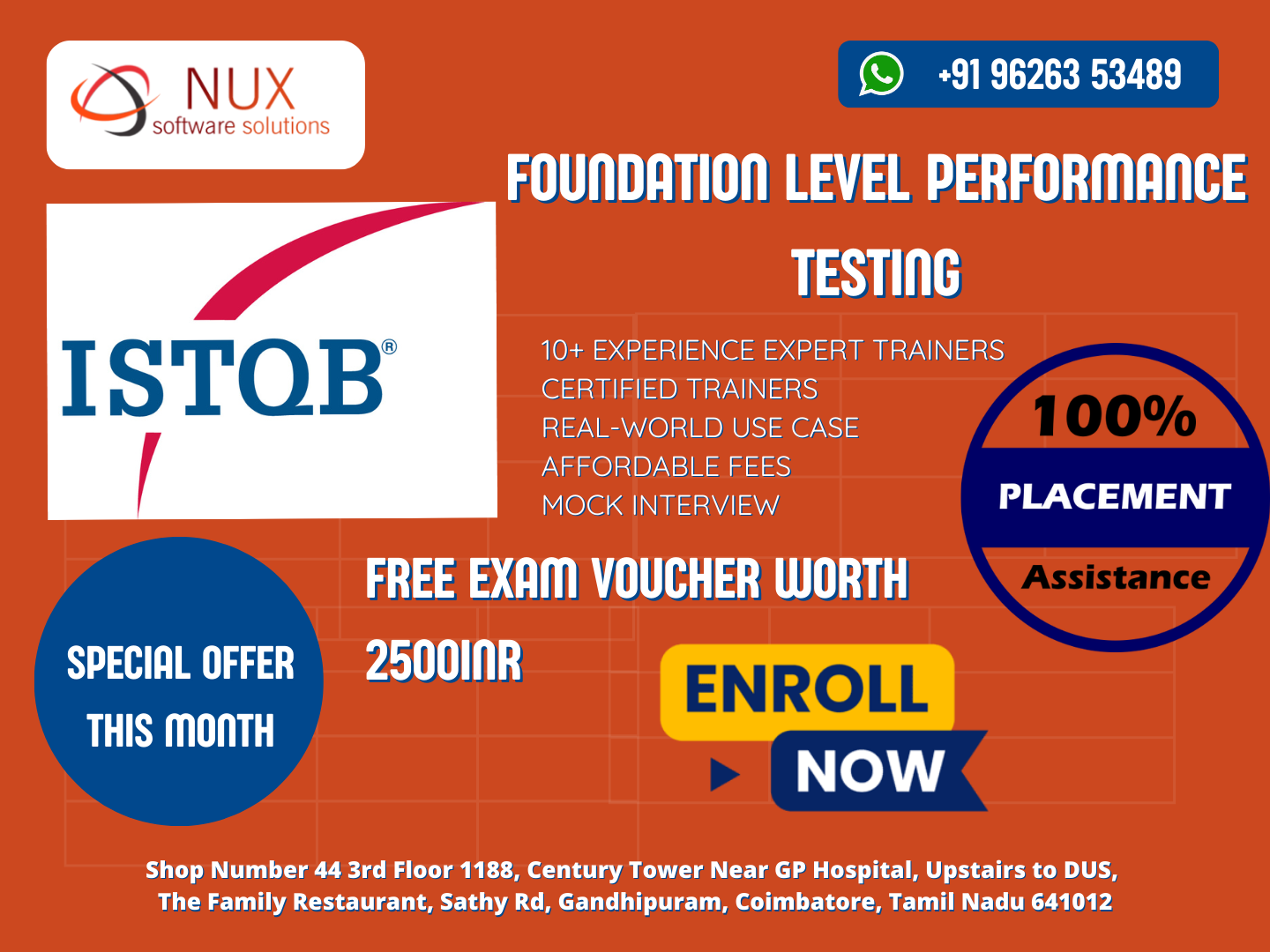Advanced Level Security Tester Training


Nux software solutions in coimbatore has excellent and advanced training programs that will give you better performance & hands on experience. Our industry’s expert trainers offer a wide range of skills and experience in their graded areas.
The Training center environment is too good for professional, individual, corporate, live project training and industrial training. Labs infrastructure is advanced, well managed and you can access LAB 24X7 from anywhere. Training center has international expert trainers and they have excellent knowledge, real time industry experience.
Our Training programs combine with several innovative learning methods and delivery models. We understand your requirement and it will give you 100 percent growth for your career and provide the cost effective training programs and also work with flexibility for the trainees.
This Foundation level usability testing course is designed to teach participants the essentials of usability and how to effectively evaluate usability, user experience and accessibility. You will learn how to plan and prepare for usability testing and select the most appropriate testing location and participants. After understanding the application of usability reviews, testing and surveys you will be able to propose the most effective usability testing approach.
Testers, test analysts, test engineers, test consultants, test managers, user acceptance testers, and software developers working on usability issues will find this course useful, informative, and fun. We suggest that attendees hold the ISTQB Foundation Level certificate, especially if they intend to take the ISTQB Usability Tester exam, but non-certificate holders can benefit from the course.
Course Syllabus
Module
Introduction to this Syllabus
0.1 Purpose of this Document
0.2 Overview
0.3 Examination
0.4 How this Syllabus is Organized
0.5 Definitions
0.6 Level of Detail
0.7 Learning Objectives / Level of Knowledge
1 The Basis of Security Testing
1.1 Security Risks
1.1.1 The Role of Risk Assessment in Security Testing
1.1.2 Asset Identification
1.1.3 Analysis of Risk Assessment Techniques
1.2 Information Security Policies and Procedures
1.2.1 Understanding Security Policies and Procedures
1.2.2 Analysis of Security Policies and Procedures
1.3 Security Auditing and Its Role in Security Testing
1.3.1 Purpose of a Security Audit
1.3.2 Risk Identification, Assessment and Mitigation
1.3.3 People, Process and Technology
2. Security Testing Purposes, Goals and Strategies
2.1 Introduction
2.2 The Purpose of Security Testing
2.3 The Organizational Context
2.4 Security Testing Objectives
2.4.1 The Alignment of Security Testing Goals
2.4.2 Identification of Security Test Objectives
2.4.3 The Difference Between Information Assurance and Security Testing
2.5 The Scope and Coverage of Security Testing Objectives
2.6 Security Testing Approaches
2.6.1 Analysis of Security Test Approaches
2.6.2 Analysis of Failures in Security Test Approaches
2.6.3 Stakeholder Identification
2.7 Improving the Security Testing Practices
3. Security Testing Processes
3.1 Security Test Process Definition
3.1.1 ISTQB Security Testing Process
3.1.2 Aligning the Security Testing Process to a Particular Application Lifecycle Model
3.2 Security Test Planning
3.2.1 Security Test Planning Objectives
3.2.2 Key Security Test Plan Elements
3.3 Security Test Design
3.3.1 Security Test Design
3.3.2 Security Test Design Based on Policies and Procedures
3.4 Security Test Execution
3.4.1 Key Elements and Characteristics of an Effective Security Test Environment
3.4.2 The Importance Of Planning and Approvals in Security Testing
3.5 Security Test Evaluation
3.6 Security Test Maintenance
4. Security Testing Throughout the Software Lifecycle
4.1 The Role of Security Testing in a Software Lifecycle
4.1.1 The Lifecycle View of Security Testing
4.1.2 Security-Related Activities in the Software Lifecycle
4.2 The Role of Security Testing in Requirements
4.3 The Role of Security Testing in Design
4.4 The Role of Security Testing in Implementation Activities
4.4.1 Security Testing During Component Testing
4.4.2 Security Test Design at the Component Level
4.4.3 Analysis of Security Tests at the Component Level
4.4.4 Security Testing During Component Integration Testing
4.4.5 Security Test Design at the Component Integration Level
4.5 The Role of Security Testing in System and Acceptance Test Activities
4.5.1 The Role of Security Testing in System Testing
4.5.2 The Role of Security Testing in Acceptance Testing
4.6 The Role of Security Testing in Maintenance
5.0 Testing Security Mechanisms
5.1 System Hardening
5.1.1 Understanding System Hardening
5.1.2 Testing the Effectiveness of System Hardening Mechanisms
5.2 Authentication and Authorization
5.2.1 The Relationship Between Authentication and Authorization
5.2.2 Testing the Effectiveness of Authentication and Authorization Mechanisms
5.3 Encryption
5.3.1 Understanding Encryption
5.3.2 Testing the Effectiveness of Common Encryption Mechanisms
5.4 Firewalls and Network Zones
5.4.1 Understanding Firewalls
5.4.2 Testing Firewall Effectiveness
5.5 Intrusion Detection
5.5.1 Understanding Intrusion Detection Tools
5.5.2 Testing the Effectiveness of Intrusion Detection Tools
5.6 Malware Scanning
5.6.1 Understanding Malware Scanning Tools
5.6.2 Testing the Effectiveness of Malware Scanning Tools
5.7 Data Obfuscation
5.7.1 Understanding Data Obfuscation
5.7.2 Testing the Effectiveness of Data Obfuscation Approaches
5.8 Training
5.8.1 The Importance of Security Training
5.8.2 How to Test the Effectiveness of Security Training
6.0 Human Factors in Security Testing
6.1 Understanding the Attackers
6.1.1 The Impact of Human Behavior on Security Risks
6.1.2 Understanding the Attacker Mentality
6.1.3 Common Motivations and Sources of Computer System Attacks
6.1.4 Understanding Attack Scenarios and Motivations
6.2 Social Engineering
6.3 Security Awareness
6.3.1 The Importance Of Security Awareness
6.3.2 Increasing Security Awareness
7.0 Security Test Evaluation and Reporting
7.1 Security Test Evaluation
7.2 Security Test Reporting
7.2.1 Confidentiality of Security Test Results
7.2.2 Creating Proper Controls and Data Gathering Mechanisms for Reporting Security Test Status
7.2.3 Analyzing Interim Security Test Status Reports
8.0 Security Testing Tools
8.1 Types and Purposes of Security Testing Tools
8.2 Tool Selection
8.2.1 Analyzing and Documenting Security Testing Needs
8.2.2 Issues with Open Source Tools
8.2.3 Evaluating a Tool Vendor's Capabilities
9.0 Standards and Industry Trends
9.1 Understanding Security Testing Standards
9.1.1 The Benefits of Using Security Testing Standards
9.1.2 Applicability of Standards in Regulatory Versus Contractual Situations
9.1.3 Selection of Security Standards
9.2 Applying Security Standards
9.3 Industry Trends
9.3.1 Where to Learn of Industry Trends in Information Security
9.3.2 Evaluating Security Testing Practices for Improvements



